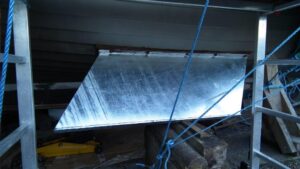
New bilge keels fabricated from 9mm steel
Liberty, the F24 that sailed this year (2020) after 4 years of restoration, was deemed by marine insurance surveyors to be beyond economic repair following damage to her starboard frames and planking. The injuries were caused through a bilge keel when bow waves from a passing vessel caused the keel to strike the ground.
The Finesse was manufactured with a choice of a drop keel or bilge keels. In reality, the drop keel was a default choice. Some had steel bilge keels as well, and these substantial items were designed to allow the boat to

Frames broken above the bilge stringer
stand upright when drying out. Each is attached to the hull by 5 pairs of bolts which pass through a wooden shoe (to adapt to the curvature of the hull). Inside, the bolts pass through the 4” x 1 1/4” bilge stringer which runs the length of the boat inside the frames. The space between the hull planks and the stringer is taken up by filling pieces. The bilge stringer construction is designed to withstand a force equivalent to a portion of the weight of the boat, since a boat without bilge keels will lie over on this part of the hull when drying out. The whole bilge keel structure is, therefore, extremely strong in compression.
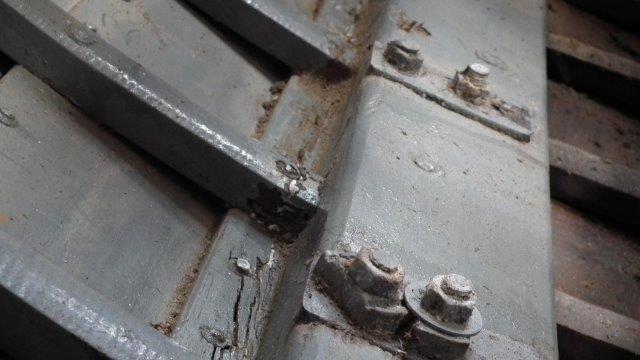
Broken frames, and two pairs of the bilge keel bolts
The bilge keel option has advantages and disadvantages. They make drying out much more comfortable and they help upwind sailing without deploying the drop keel. On the other hand, a grounded boat cannot be freed by tilting over to reduce the draught; the keels can become foul with floating weed; they present a small increase in hull drag; and they add to the maintenance of the boat, requiring anodes for corrosion protection and periodic bolt renewals.
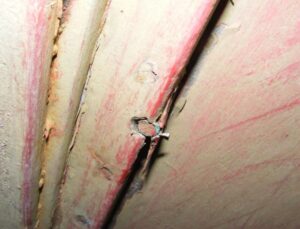
Copper fastenings torn out of the planking
No-one was present when Liberty was damaged. The marine surveyor suggested that the planks and frames failed as a result of the starboard bilge keel being crushed inwards as the boat dropped off the bow wave. However, it seems more plausible to me that the keel dug into the ground and acted as a lever, temporarily twisting the bilge stringer in the centre of its length. In this scenario, the frames and planks were torn apart; there is evidence of copper fastenings being ripped out of their planks.
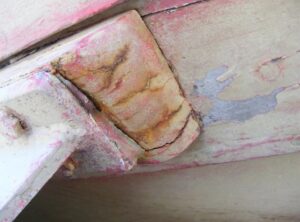
The shoe between the keel and the hull was fractured
Whatever happened, it was obviously an extremely traumatic event for the boat. What lessons can be learned? A boat fitted with bilge keels needs sheltered conditions for drying out, that much is clear. Possibly the bilge keels are too robust- they could have acted as the weakest link and deformed sacrificially. There is food for though there for those who have these keels or for anyone considering retro-fitting them. As for Liberty- she has been sold to a Falmouth boatyard. The only repair scenario that made any sense was that the labour and boat-building skills would be supplied by her next owner.
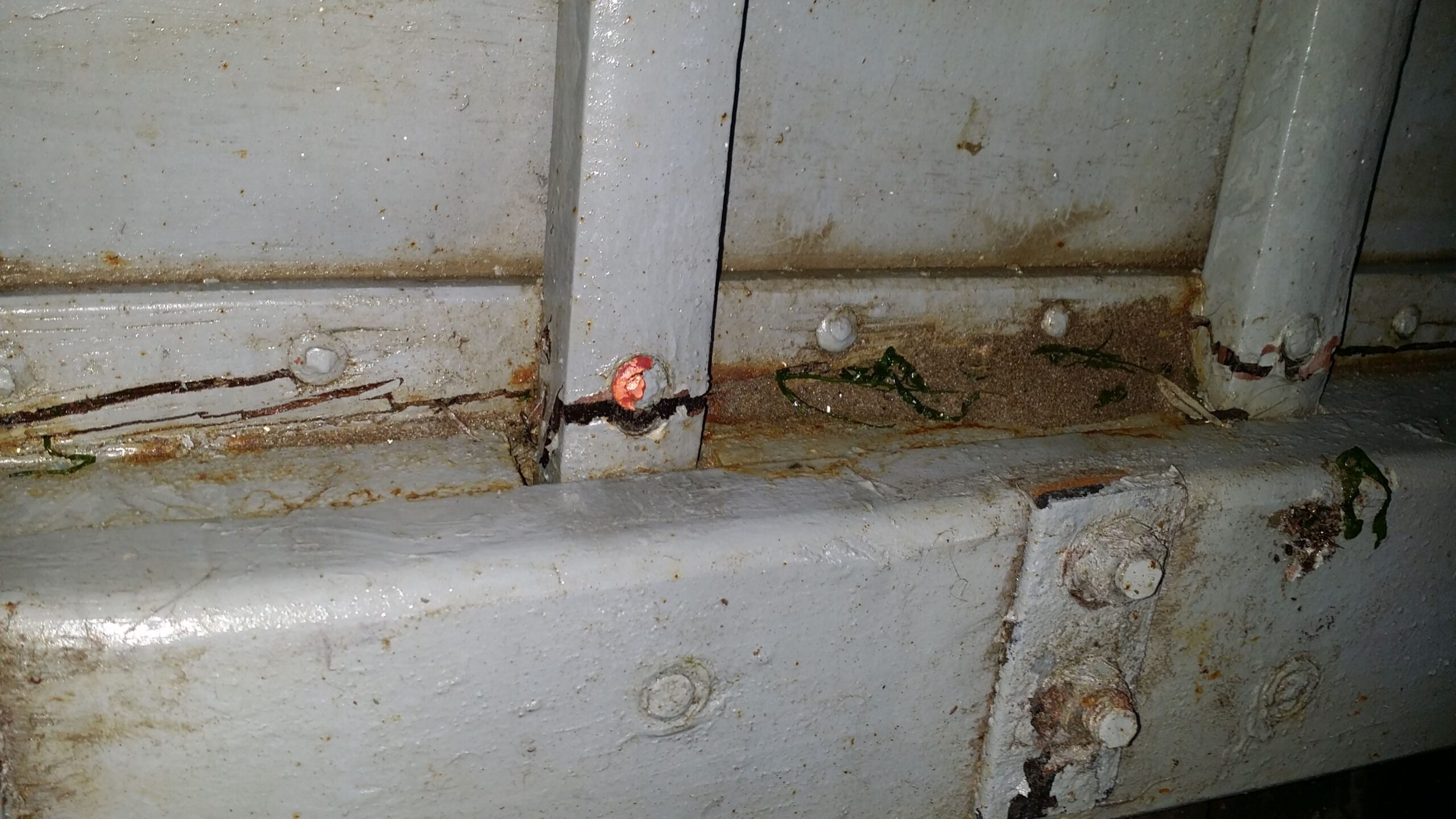
Broken frames and split planking- this was a traumatic event
My thanks to Hugh Brading, the previous owner, and to Martin Patten at Marine Techniques for sight of his damage survey. -DM



No, Dave, boats without ‘bilge keels’ will lie over on their bilge stubs, which are around 250-300 mm deep. Construction remains the same.
The problem with full depth bilge keel is the same as discovered with the bolted bilge keeled Westerly (26) in that sometimes as they float up/ground the boat twists on the keel. Many a boat of this design has suffered, larger Westerly’s too. This proved the undoing of F24 Mariette after her conversion to triple keels and removal of centre plate – and another I can’t remember name of.
When a ‘standard’ boat grounds, weight is supported through boat’s back bone well before canting over and coming to rest on whatever bilge stub.
As for shallow depth sailing, I would argue that the triple keel version would suffer same fate as a modern bilge keeler, ie, once you get on, unless lucky, one would need to await the next rising tide.
I have sailed Whimbrel in and out of shallow tricky creeks with little room for manoeuvre for some years … a touch of plate helps, but tacking can be comfortably achieved providing breeze enough to make boat go, when getting round is more important than a few lost metres in ground made good.
The boats were designed like this for this very reason: well suited to the open (from south) conditions in their home waters of the Southend/Leigh-on-Sea shore of the Lower Thames.
I have never liked the triple keel version, with or without a centre plate: both versions were built for original owners.
The triple keeled boats should have had several spreader floors to take the twisting forces encountered when the whole weight of the boat is felt by a bilge keel.
The ‘standard’ boat had the tried and tested bilge stubs. Mariette has had her full depth bilge keels removed back to her standard stubs.
Other thasn that, nice article and let us hope she finds another caring owner: she’s a lovely boat (Pictures of her in my Alan Platt story in ‘Jottings’ …)
Maybe, Mariette’s new owner can dish up any alteration pictures too…
Thanks Dave and Nick for your comments. There are several facts not recorded
1) Just as Liberty was about to float 4 trawlers left Bideford Harbour the morning that the damage occurred. Two days later I witnessed the same trawlers heading out. Their wash lasted more than 20 minutes and would certainly have rolled Liberty violently as she started to come afloat. Within an hour it was noted by people living adjacent to her mooring that she was “low in the water”. ” others soon noticed and one of them towed her off her mooring and beached her. When I arrived it was evident the 3 bilge pumps had been over whelmed and they were rated to pump 2000 gals per hr. 2) there was no evidence of the bilge keels digging in the sand the line of the keel was still very clear. The paint on the 4 x 1 1/4″ stringer shows no sign of cracking which it should were the stringer twisted something the Surveyor and I commented on.
Hugh, I didn’t state as much, but it was the passing of a twin hulled ‘fishing’ boat and resultant draw-down and deep movement of water that is thought to have caused Mariette’s problems.
What it shows is, that along with ‘Westerly’ type problems, full depth bilge keels grounding are a concern to bear in mind as to where one is berthed – as the Seaking 26′ owner off Leigh-on-Sea has found…
Pingback: Sand legs and sand pipes |